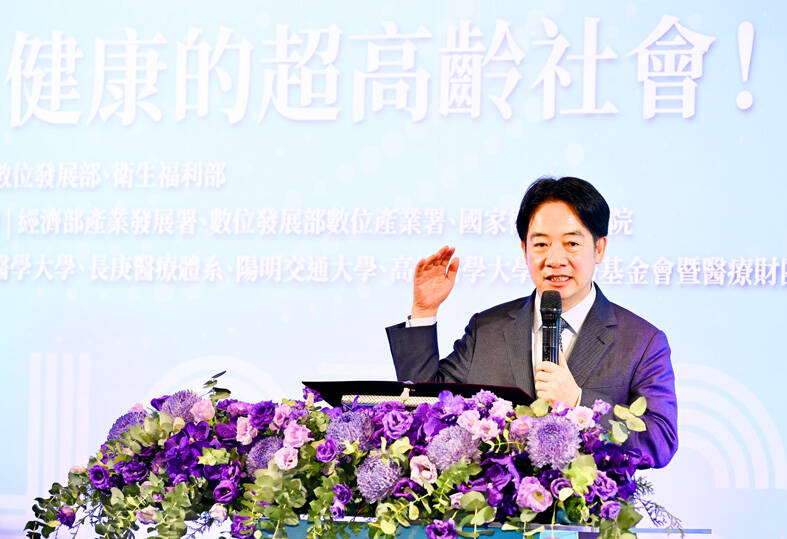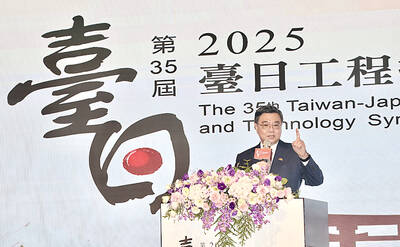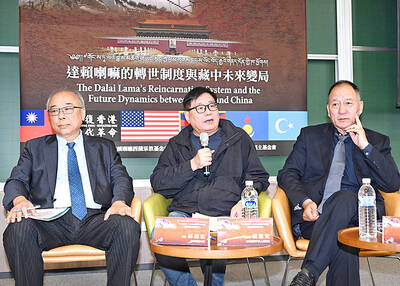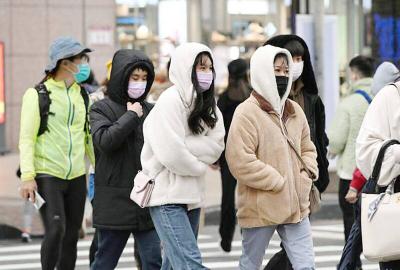President William Lai (賴清德) at a tech expo about healthy aging on Friday praised Taiwan’s strengths in healthcare and technology for being able to provide a new economic opportunity.
Lai said Taiwan can make good use of its competitiveness in the technology and healthcare services sectors to “create a new industrial path” and serve as an experimental market for international innovative technology.
“Taiwan’s life expectancy is about 80 or so years old, but records show that the average Taiwanese spend about one-tenth of their lives, or eight years, requiring care for health issues,” he said.

Photo: Lo Pei-de, Taipei Times
A former physician himself, Lai said one of his presidential campaign promises was a “healthy Taiwan,” aimed at promoting good health for the public and making healthcare technology one of the country’s strengths.
Companies and research institutes participating in the expo are showcasing their new services and products utilizing digital technologies.
The Industrial Technology Research Institute, for example, had a care solution which uses image recognition technology to distinguish changes in an older person’s movements and cognitive behavior.
There were also information and communication technology (ICT) companies with artificial intelligence (AI)-related exhibits, such as Acer using AI to evaluate a person’s risk of osteoporosis and Compal detecting possible depression and dementia with the technology.
Taiwan would become a super-aged society by next year, meaning that more than 4.68 million, or 20 percent of its population, would be aged 65 or older, Institute for Biotechnology and Medicine Industry adviser Shen Jong-chin (沈榮津) said.
An estimated 35 percent of the labor force (under the age of 65) would have to quit their jobs to take care of their aged family members, he said.
It is therefore urgent for Taiwan to develop a health industry founded on technology to meet the challenge and serve the “silver economy,” Shen said, referring to markets catering to the needs of older people.
Such an industry could also support the ministry’s policy to attract foreign tourists, including those coming for medical tourism, especially from neighboring countries such as Japan, South Korea and other Southeast Asian nations, Minister of Economic Affairs J.W. Kuo (郭智輝) said.
Taiwan can leverage its advantages in AI and ICT to build a health industry ecosystem encompassing dietary management, sports management, prognosis and rehabilitation, Kuo said.
The expo is taking place until today at the Taipei World Trade Center’s Exhibition Hall 1.

ALIGNED THINKING: Taiwan and Japan have a mutual interest in trade, culture and engineering, and can work together for stability, Cho Jung-tai said Taiwan and Japan are two like-minded countries willing to work together to form a “safety barrier” in the Indo-Pacific region, Premier Cho Jung-tai (卓榮泰) yesterday said at the opening ceremony of the 35th Taiwan-Japan Modern Engineering and Technology Symposium in Taipei. Taiwan and Japan are close geographically and closer emotionally, he added. Citing the overflowing of a barrier lake in the Mataian River (馬太鞍溪) in September, Cho said the submersible water level sensors given by Japan during the disaster helped Taiwan monitor the lake’s water levels more accurately. Japan also provided a lot of vaccines early in the outbreak of the COVID-19 pandemic,

Kaohsiung Mayor Chen Chi-mai (陳其邁) on Monday announced light shows and themed traffic lights to welcome fans of South Korean pop group Twice to the port city. The group is to play Kaohsiung on Saturday as part of its “This Is For” world tour. It would be the group’s first performance in Taiwan since its debut 10 years ago. The all-female group consists of five South Koreans, three Japanese and Tainan’s Chou Tzu-yu (周子瑜), the first Taiwan-born and raised member of a South Korean girl group. To promote the group’s arrival, the city has been holding a series of events, including a pop-up

TEMPORAL/SPIRITUAL: Beijing’s claim that the next Buddhist leader must come from China is a heavy-handed political maneuver that will fall flat-faced, experts said China’s requirement that the Dalai Lama’s reincarnation to be born in China and approved by Beijing has drawn criticism, with experts at a forum in Taipei yesterday saying that if Beijing were to put forth its own Dalai Lama, the person would not be recognized by the Tibetan Buddhist community. The experts made a remarks at the two-day forum hosted by the Tibet Religious Foundation of His Holiness the Dalai Lama titled: “The Snow Land Forum: Finding Common Ground on Tibet.” China says it has the right to determine the Dalai Lama’s reincarnation, as it claims sovereignty over Tibet since ancient times,

Temperatures in some parts of Taiwan are expected to fall sharply to lows of 15°C later this week as seasonal northeasterly winds strengthen, the Central Weather Administration (CWA) said today. It is to be the strongest cold wave to affect northern Taiwan this autumn, while Chiayi County in the southwest and some parts of central Taiwan are likely to also see lower temperatures due to radiational cooling, which occurs under conditions of clear skies, light winds and dry weather, the CWA said. Across Taiwan, temperatures are to fall gradually this week, dropping to 15°C to 16°C in the early hours of Wednesday